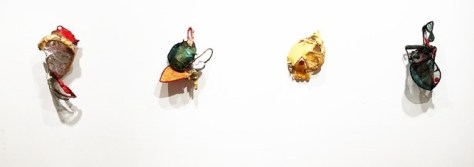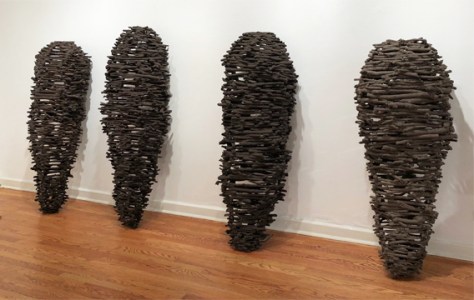When two artists show their work together, the urge to compare and contrast is almost irresistible. “On the one hand this, and on the other hand that” becomes the template for evaluation and appreciation. Artists Aviva Alter and Marzena Ziejka invite this even more, because they do, in fact, have quite a lot in common. Their 2-person show, From Bits and Pieces, is on exhibit at Firecat Projects, 2124 N. Damen Avenue, Chicago, until November 11, 2017.
Alter and Ziejka share their eastern european heritage. Alter is a second-generation American with German and Polish roots and Ziejka is a more recent arrival from Poland. The pair met several years ago at an art exhibition, got to know each other and became close friends.
As they began planning From Bits and Pieces, both had recently lost a parent, a shared experience that each processed in her own unique way. Alter says, “For me, the death led me into artwork about the body, death, life, healing and decay.” Ziejka struggled to understand how her creation of an object could somehow stand for the longed-for and absent parent. Her father was constantly mending and tending, and Ziejka recognizes this impulse in her own art practice. “Isn’t it a process of our lives? We are collecting, arranging and re-arranging things until we are lost in them or in the process or both.”
Both artists have strong backgrounds in traditional crafts, but neither is content to work within accepted traditions, and each seems compelled to push the boundaries of her craft and art. They are hunter-gatherers, (Alter in an urban setting and Ziejka in the country), collectors of inspiration from the detritus of civilization and nature.
Aviva Alter
Alter began her life as an artist in ceramics, working as a studio potter (and later director) at Lillstreet Street Art Center. She grew and adapted along the way, adding fiber and printmaking to her skill set, mixing and matching her various abilities to produce hybrid artworks that resist easy categorization.
She learned to crochet as part of the gloriously luxuriant Crochet Coral Reef Project and subsequently led the development of the Cambrian Reef shown at the Chicago Cultural Center, the Cooper Hewitt Design Museum and the Smithsonian.

Alter’s recent work, exhibited here, takes an ad hoc approach to art-making. The technical requirements of a particular craft vocabulary have been jettisoned for an experimental, provisional process that yields smallish constructs that might be improvised cricket cages or handcrafted internal prosthetics. She describes her process: “[it] began with my obsession for gathering discarded bits of information, assembling and reassembling them to create an order of my own invention… focusing on processes that disguise the original function of the found objects, these forms become amalgamations of broken bits and pieces of my world.” The results are ephemeral-seeming objects that feature fragile, sheer and translucent materials held together by irregular stitching, tying and wrapping. Sticks, wire and found fragments form the armature, and are covered by gauze, string and metal mesh, overlaid by waxy color.
Marzena Ziejka
Marzena Ziejka has worked as a professional weaver of tapestry, miniature painter, graphic designer and illustrator. Born and raised in Tarnow Poland, she grew up on a farm and was attracted to the earthy qualities of farm materials: soil, unprimed canvass, horse hair and sticks. The natural materials she employs speak of her past, her absent father and exile from a lost place and time. She writes, ” I am from the land where soil, earth is not called ‘dirt’/Where it is called Mother-Earth, Mother-Breadwinner.”

Through accretion and repetition, Ziejka arrives at a series of cocoon-like images. Her creative process is based on unorthodox weaving techniques using natural materials. She calls the sticks that she uses “tree bones” and the materials she employs inevitably create shapes arising from her means of production. It is a kind of nature-based constructivism. The resulting ovoid shapes look like empty mummy cases or the discarded shells of transformed bodies. They project simultaneously a sense both of ominous presence and poignant loss, as if the still-living are in dialog with the recently deceased. These artworks, while not closely resembling the more figurative work of her fellow countrywoman Magdalena Abakanowicz, convey the same pensive mood of alienation.
One of the great mysteries in art is how two artists who start with similar premises, materials and methods can end up with work that is uniquely and completely their own. It explains on some level how the individual creative impulse is the one great variable that any artist brings to her work, and that each of these artists has in abundance.


